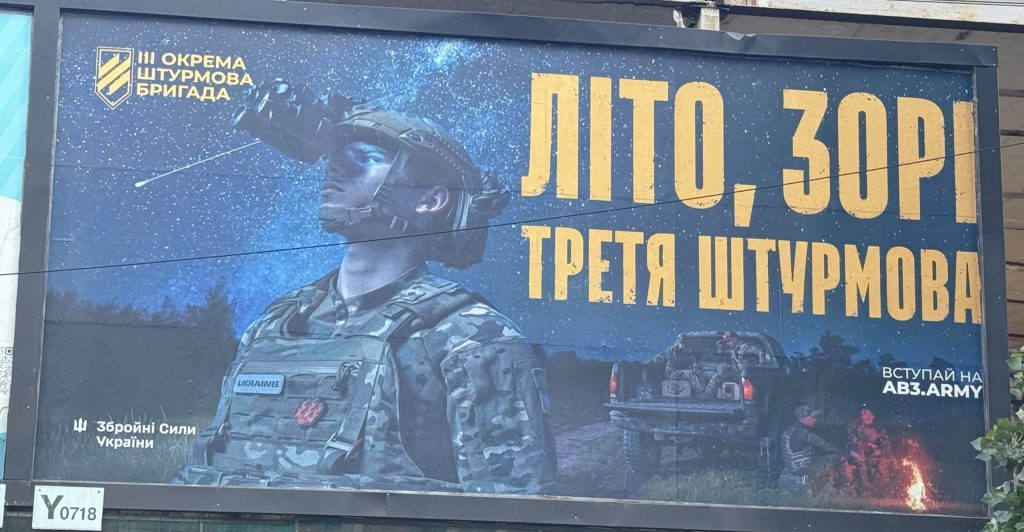Retour d’Ukraine III (Back from Ukraine III)
Text and images from Senator Philippe Folliot’s 3rd visit to Ukraine
While the decision to go back to Ukraine was taken at a meeting of the ALD during last NATO-PA session in Sofia from May 24 to 27, 2024, the time and opportunity to travel once again to the Ukrainian theater gave me pause for thought. I had the opportunity to visit the front line in the Donbass region in January 2023 where I witnessed the firing operations of the french self-propelled howitzer « CAESAR ». I went to the Zaporija region a second time with our colleague from Germany Marcus FABER (MGB) to see Leopard tanks and french AMX10-RCs in action.
First of all, is it important for Ukrainians? Then, it is it useful? Finally, is it dangerous?
Alexander Zavitnevych, Chairman of the Rada’s Committee on National Security, Defense and Intelligence, and his Vice-Chairman Yehor Cherniev (head of the delegation to the NATO-PA) reassured us on this point. In fact, for them, as parliamentarians, but also for all the interlocutors we’ll be meeting, and more particularly the fighting forces on the front line, the fact that a delegation made up of three members of the NATO Parliamentary Assembly was going there was a very strong symbol, even more if they can reach as close as possible to the ground and the front line. I think it’s also a good thing for parliamentarians that they know how to get out of their “comfort zone” and get closer to the realities of the front line. I’ve travelled with the same intent to Ukraine, Afghanistan, Chad, Guyana and Lebanon.
Is it useful? In my opinion yes. Because when you see things for yourself, it’s always more instructive and effective than reading reports, articles or books, which are sometimes written by people who work as a second source and haven’t been out in the field themselves. In fact I have learned a lot from the two previous visits, and I’ve passed on a lot of information and analysis (Mirage 2000, ammunition, etc.) that has ultimately been taken into account, but often too late.
Finally, I don’t think such visits are necessarily dangerous as long as a number of precautions are taken. Zero communication before departure and during the journey, discretion is the best guarantee of safety. Well aware that I am once again visiting a country classified by our ministry of foreign affairs (Quai d’Orsay) as a “red zone” (travel forbidden), I warned the President of the French Senate Gérard LARCHER, the Chairman of the Foreign Affairs, Defense and Armed Forces Committee, Cédric PERRIN, and the French Ambassador to Ukraine.
Voyage (The journey)
On the train to Kiev, I noticed that the carriages were more modern and recent than on my first visit in January 2023. Leaving Warsaw on Friday at 6pm, we arrived at Kiev station on Saturday at around 1pm. It takes a long time, but I’m getting used to it. With my colleague and friend Mikko SAVOLA, Finnish MP, we took the opportunity to exchange our parliamentary experiences, talk about our countries’ respective aid to Ukraine, and exchange views on geostrategic world issues…
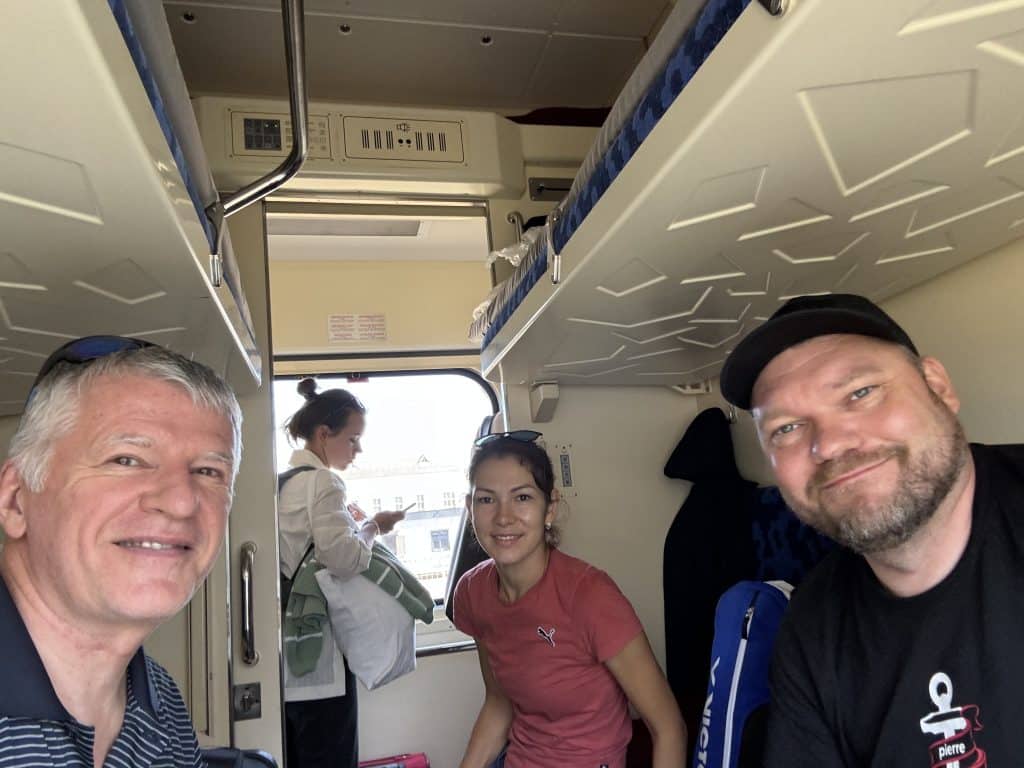
The presence of a young Ukrainian woman returning from a brief stay in Warsaw gave us the opportunity to ask her about her feelings as a civilian on the conflict, the mobilization, the consequences of the Russian strikes on energy infrastructures, and her feelings about the outcome of the war.
As usual, Yehor Cherniev, head of the ukrainian NATO-PA delegation, was on hand to greet us with his eternal smile and infinite kindness as we waited for our colleague Marko MIHKELSON, Estonian MP, who had arrived the day before with a utility vehicle from Tallinn to carry out humanitarian work north of Kiev.
Symboles (Symbols)
This first day which was in fact a national holiday (in its simplest form due to the circumstances), was dedicated to highly symbolic actions in the capital. First of all, there was a meeting with Mr. Olexandre Urin, deputy director of the Kiev paediatric hospital “Support for Mothers and Children”, which was bombed by Russian missiles on July 8 which of course caused widespread indignation.
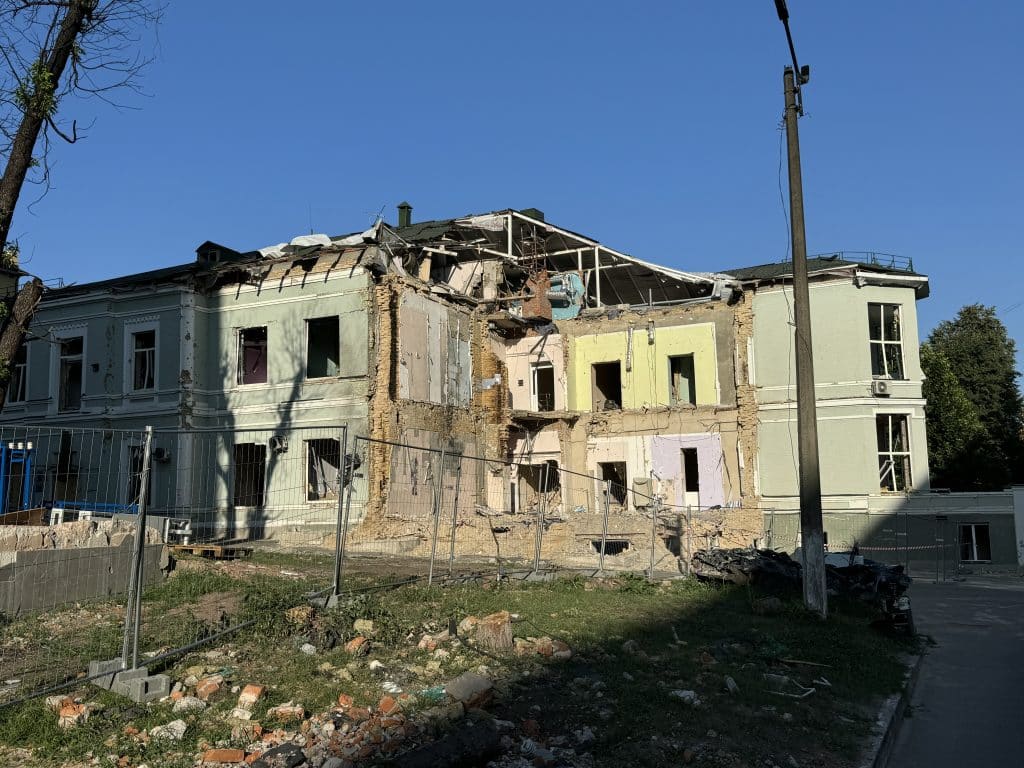
Mr. Olexandre and his communications director first gave us a tour of the site, recounting the events as they unfolded, and explaining that although the material damage was considerable, luckily (should we say luck!) there were « only two fatalities » in the affected administrative building and over 300 injured, many of them children, mainly from shards of glass. This hospital, with its 300 children and 2,000 employees, performs 20,000 operations a year with enormous material constraints. In some respects the humanitarian situation is similar to that in Gaza.
The second symbolic moment of the afternoon, beyond the visit to the Basilica of Saint-Michel, was the meditation in front of the Wall of Remembrance, where photos of all the fighters who have died since 2014 are displayed. Despite the extreme length of the wall, we were told that it was already too small to show the extent of the demographic drain in Ukraine, particularly for young men in the 27-45 age bracket. With the recent exception of those under 25, students and fathers of more than three children, all Ukrainians between the ages of 25 and 60 have to make themselves available to the army, unless they work in the defense industry, or in essential activities such as energy, transport, civil protection, hospitals, etc.
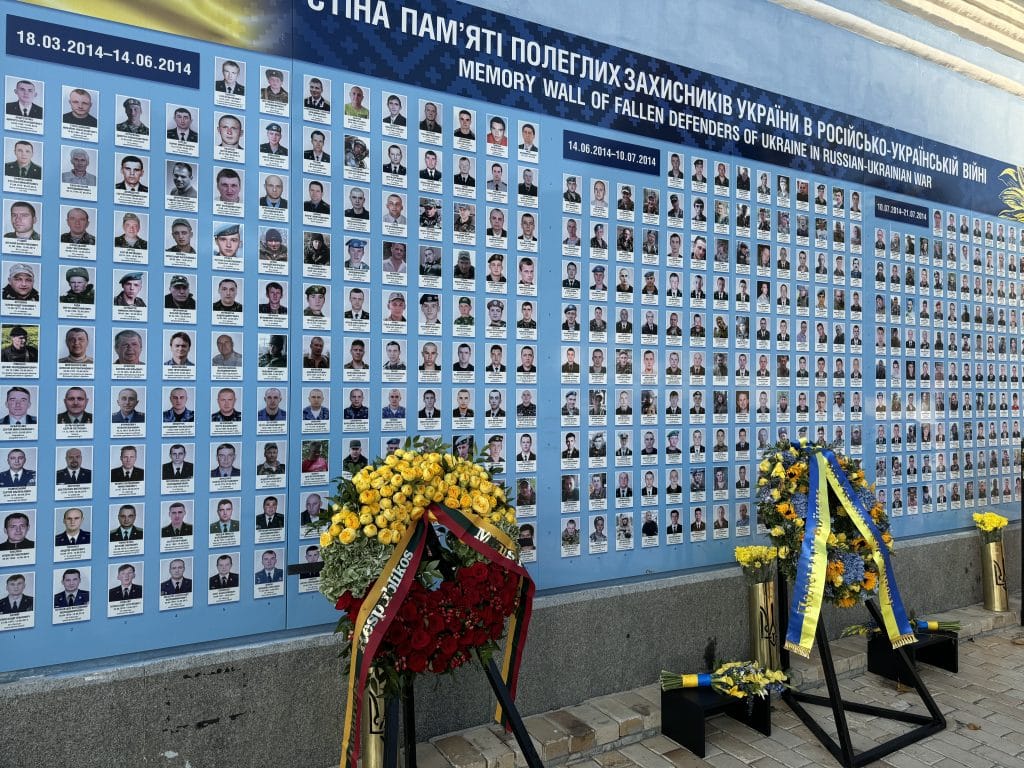
As we passed our hotel, Yehor explained that on this very spot, in May 2017, the FSB services had killed in the middle of the street Russian deputy Denis VORONENKOV (deputy from 2011 to 2016), whose only crime had been to challenge Putin and oppose the first 2014 intervention in Ukraine. Putin also has the blood of his fellow opponents on his hands.
Magnit (Callsign « Magnit »)
Yehor surprised me by inviting « Magnit » to dinner. Magnit is a true hero, one of those Ukrainian relentless shadow fighters, a man of duty. On the front line, he defends his country with determination. I met him the first time I went to Ukraine. He gave his name to the reporting of my first journey. I saw him again in July 2023 near the front line, where his enigmatic smile was matched only by his determination. Near Marinka, in early May, he was seriously wounded in the foot and arm in a shelling. He spent endless hours bleeding to death, hidden in a shell hole, with no possibility to retreat. Miraculously, two of his men, under a continuous barrage of artillery fire, were able to transport him to the rear so that he could first be stabilized, then evacuated for surgery. Yehor had shown me photos in which he appeared calm, smoking a cigarette, masking his pain, but always with the same look, of one who doesn’t know if he’s going to die, but who is sure of having done his duty. In this photo, I see him bareheaded, without a bulletproof vest. Magnit told me that whenever he went to the front line, he preferred to be more mobile and lighter, therefore not wearing a helmet or a vest, but carrying as much ammunition as possible. When I hear him on the balance between protection and mobility, I remember the exchanges I had with paratroopers from the 8th Marine Infantry Parachute Regiment of Castres (South of France).
Throughout the meal, beyond the language barrier, he spoke relatively little. When I asked him about this, he replied that he was most concerned about his brothers-in-arms in the field, and that he was eager to join them as soon as possible to continue the fight. They told me that all those I had met on that memorable evening in January 2023, a few kilometers from Bakhmout, were all alive and fighting. However… I wasn’t able to verify it.
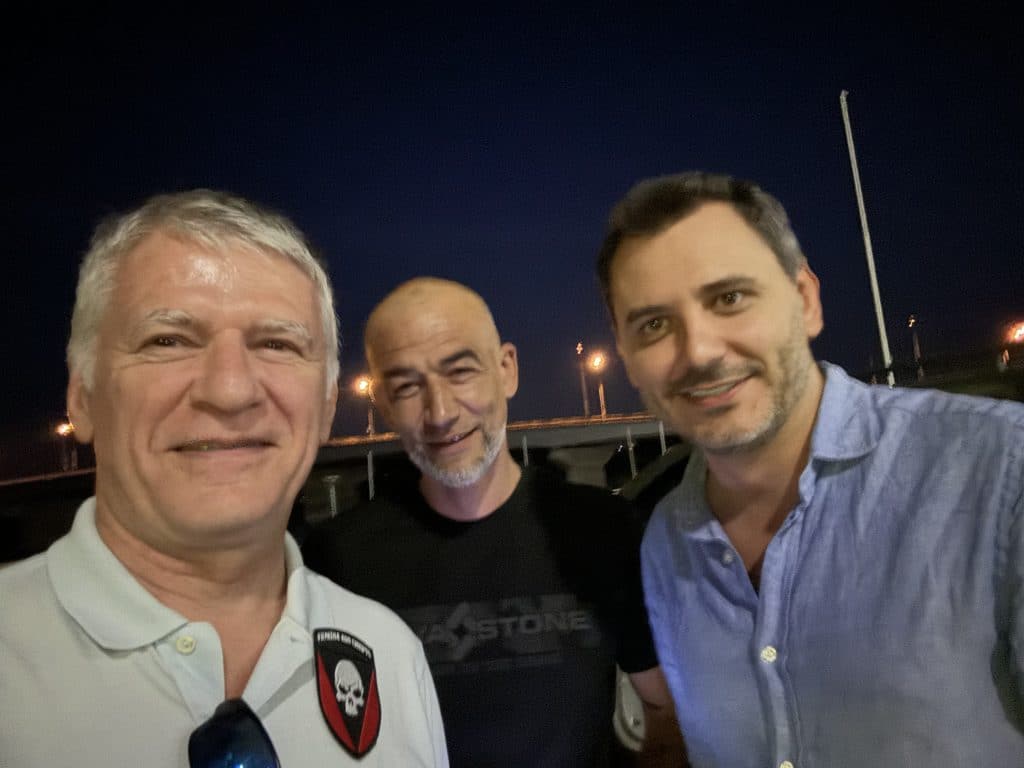
Before leaving, Magnit presented me with his unit’s crest (with a skull and crossbones), a bottle of old vodka, which I understand was found in the basement of a devastated house they had taken over from the Russians, and offered it to me so kindly and generously that I was deeply moved. I gave him a bottle of Armagnac I’d brought from France, and we promised each other that, hopefully as soon as the conflict was over, we’d meet in Paris to drink vodka, and at his place in Kiev to drink Armagnac.
Résilience (Resilience)
Early Sunday morning Marko joined us. We five MPs and a driver set off in an unmarked car. We knew we were going to Kharkiv, Ukraine’s third-largest city, the closest to the Russian border. The city had suffered a lot of heavy artillery fire between February and October 2023, before the Russians partially withdrew. Kharkiv is still as recent news has shown one of the cities where civilian are hit the hardest because of the proximity to Russia (40 km). In fact, each time, we didn’t know exactly where we were going, because for security reasons the program could always change at the last minute. We visited a factory that manufactured and repaired tanks and infantry transport vehicles, with buildings scattered over more than 400 hectares, at least a third of which was built-up. I was able to understand the true notion of « heavy industry », in the -pardon the expression- “Soviet” sense. There were huge warehouses, in which even on a Sunday afternoon a large number of workers were toiling with poor protection, where everything is piled up, but carefully scattered so that, in the event of a Russian attack, as was the case last December, things are sufficiently spread out in anonymous buildings for there to be as few consequences as possible. Machines were still working in building with gaping holes in the roof left by Russian missiles. I was reminded of my visit a few months ago to the Nexter workshops in Roanne (France), where the CAESAr self-propelled howitzers are assembled. Truly two opposing worlds!
Here, we’re in a totally different situation, where everything is manufactured on site, including the engines. We understand that soviet-era designed tanks and troop-transport vehicles are manufactured at high production rates (for obvious reasons I can’t disclose the exact numbers). Ingenuity, adaptation and resilience is something unique to them, and it was with great pride that they showed us equipments ending the test phase before being sent to the front line. Those they had just repaired would “go all the way to Kursk!” they told us.
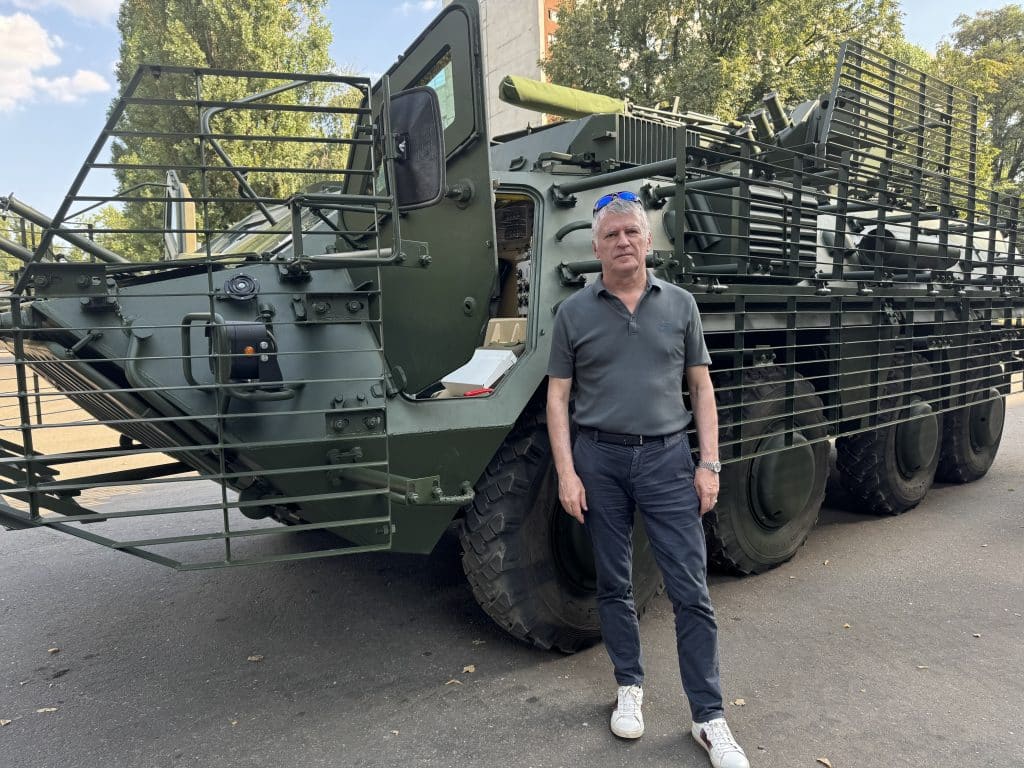
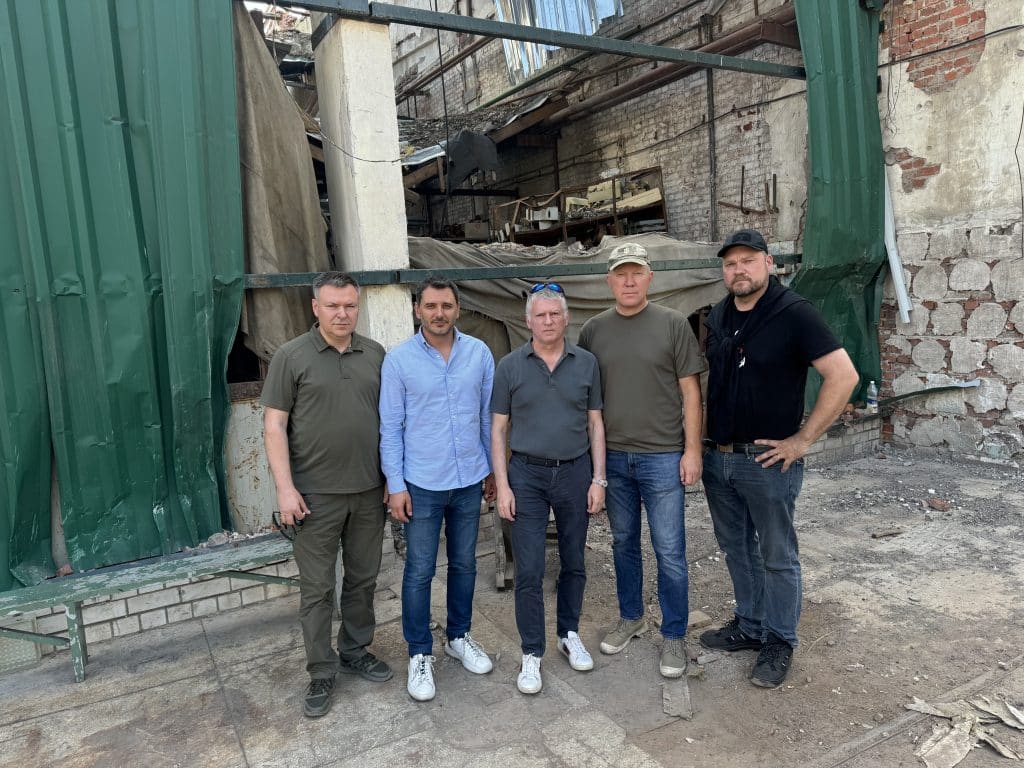
Resilience was also key in our discussions with the governor Oleh SYNIEHUBOV when he explained to us that half the schools in the region (of 1.3 million inhabitants) had been destroyed. He told us that the city welcomed each year nearly 200,000 before the war. Still they were doing their best to respond to the challenges of energy infrastructures by trying to deconcentrate them as much as possible.
It was this desire to rebuild that struck us. The will to reopen schools with shelters so that even in degraded mode the class can be held underground. In addition, he told us of their concerns about the educational and psychological consequences for some of their young people. With Covid and the war, for some children it’s been four years since they’ve seen a schoolclass.
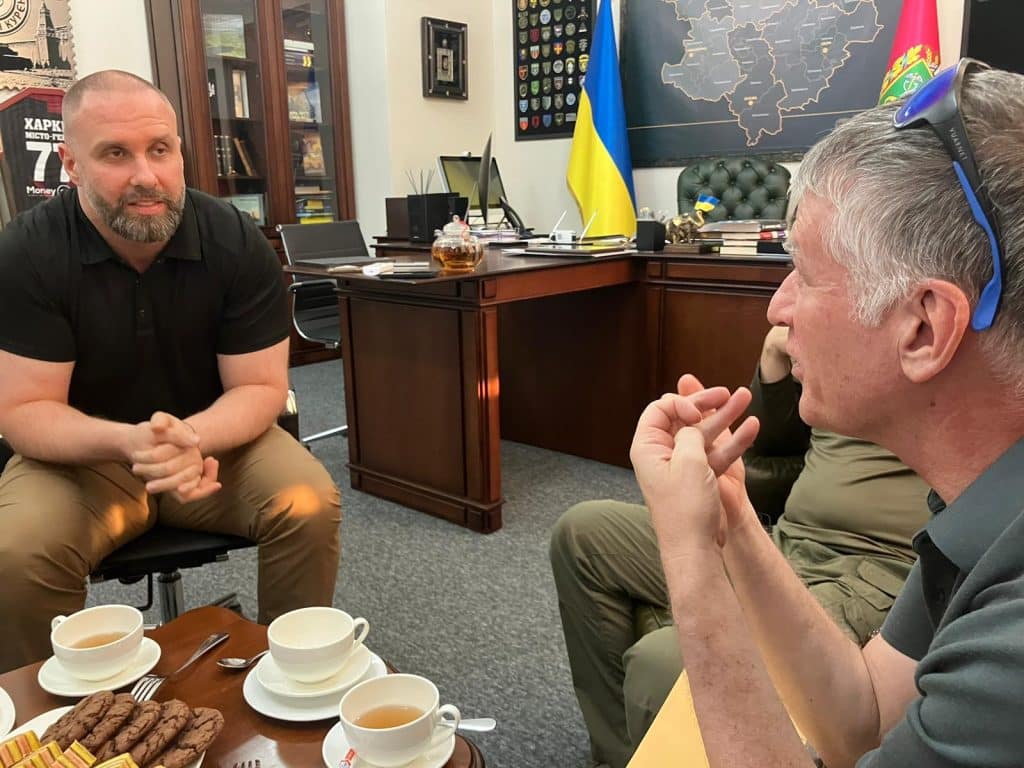
We saw this notion of resilience as we returned from dinner, where we noticed, bewildered but also admiring, all those young people (under 25) in the bars and in the streets. Despite the particularly anxiety-provoking context with constant alerts in view of the proximity of the front line and the relative weakness of airground protection against attacks by drones, missiles and gliding bombs they were going out. It was in fact a lesson in life, the “will to live” that we felt. With such moral and psychological resources, Ukraine will not lose this war. I don’t know if they’ll win it, but they can’t lose it.
The construction of buildings, bridges and roads is what we saw then: “They destroy, we rebuild, just to show them that we won’t let them intimidate us” as one of the people in charge told me. The reconstruction of a road and a bridge over a river to the north-east of Kharkiv are for me highly symbolic. Under threat, they continue to work.
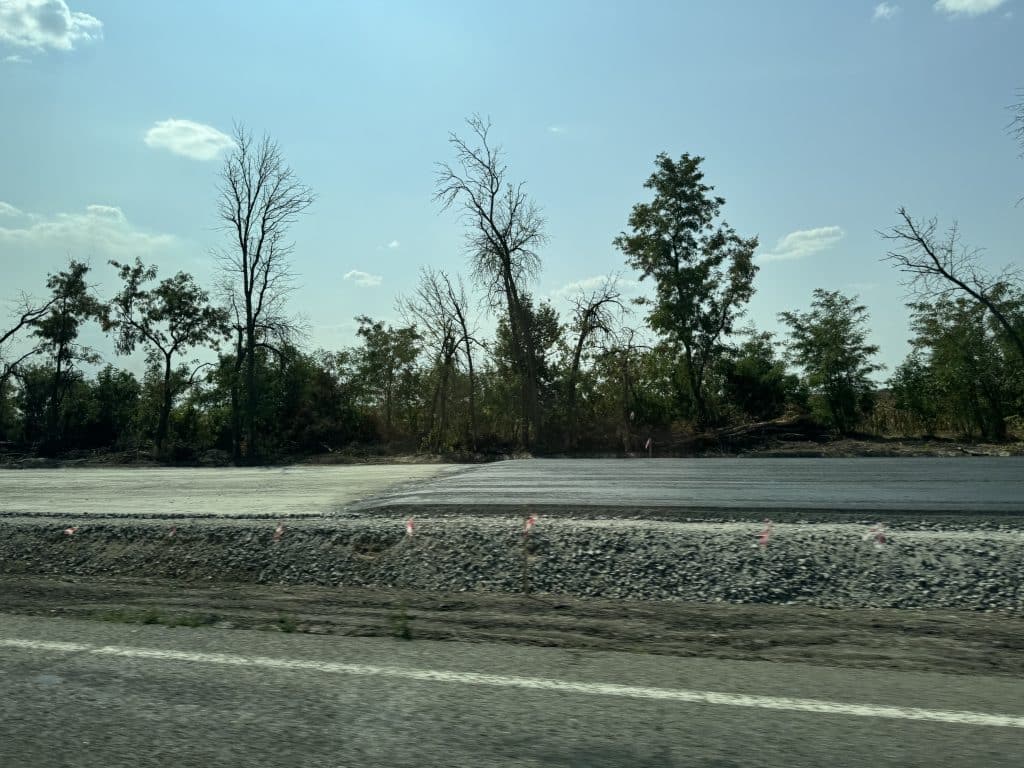
Roulette russe (Russian Roulette)
We are all familiar with the stupid game known as “Russian Roulette” in which you put a bullet in the barrel of a revolver, spin it, and pull the trigger. You have a one-in-ten chance of dying, or a nine-in-ten chance of staying alive. That’s what the people of the Kharkiv region are living, because they’re constantly under threat from shelling, but also from guided bombs and Russian drones. They can strike anywhere at any time, as Putin has long since transgressed the rules of international law, which forbids strikes against civilian targets. As you know, the night of August 26-27 was marked by the largest Russian attacks since the start of the war involving long-range missiles (127) and drones (109). A large proportion of the 127 missiles were intercepted, with varying degrees of success depending on the presence and quality of anti-aircraft defense systems. Kinjal hypersonic missiles are even more difficult to intercept. Being awakened early on Tuesday morning by a violent explosion is really an odd experience. This time, we were not in the 1/10 quota of the aforementioned roulette.
To deal with this the Ukrainians are being permanently mobile. In fact, for defense purposes there is no particular headquarters point but various locations throughout the city scattered in discreet spots. It was in an old building in the middle of nowhere that we met the commander of the 36th Brigade for a very interesting exchange, during which he told us about the situation on the ground, and more particularly about the lack of air protection… The principle of mobility was applied to our group as we spent two nights in Kharkiv in two different hotels. We were never in a convoy. At most two cars following each other, because the Russians have understood that if there are 5 or 6 vehicles following each other at high speed, there may be important or “high value” targets. Discretion is a crucial issue. Mobility and deconcentration was demonstrated to us on our visits to the front lines. We’ve seen a unit that trains soldiers before they go to the front line and an artillery support and repair unit. All this is done deep in the forest with rudimentary means. This rusticity seemed to be effective, as we were able to catch a glimpse of an American M777 gun they had just repaired. When asked about their difficulties, they replied that they still had severe shortages of spare parts and very limited access to maintenance documentation, making their task very difficult (not to mention the lack of ammunition).
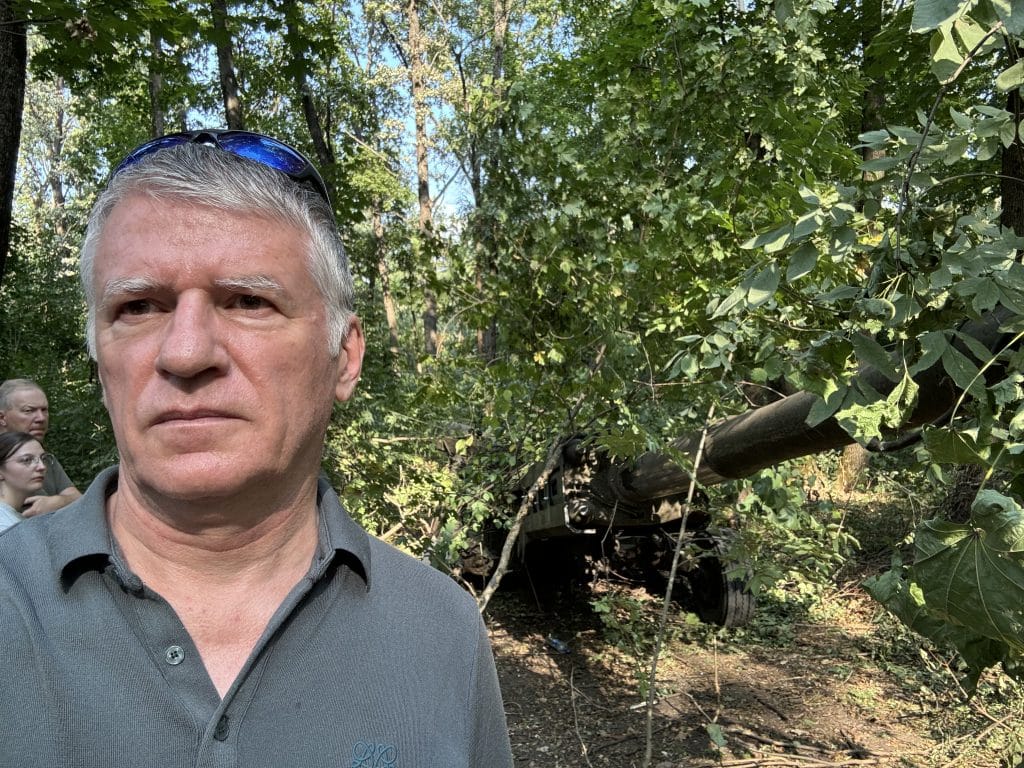
Before I left, they told me they were very interested in the french CAESAr self-propelled howitzer, which they’d heard so much about from their colleagues in other regiments. I told them that I’d seen it one operating a few months ago and that with its length, rate of fire, mobility and precision, the howitzer was indeed a formidable weapon. Our friend Mikko was particularly interested in the “Aguerrissement Center” section, as the unit was using an infantry transport vehicle donated by his country, Finland.
The ukrainian defenders took the hardiness and adaptability (one of the hallmarks of our beloved 8th Regiment) to the extreme. Exceptionally, we were able to visit the brigade’s Operations Center, located in the basement of an anonymous building. We were surprised to see a room full of screens and digital maps, where we could watch live drone footage of the front line. What a shock to see entire villages reduced to rubble by Russian artillery! At one point, we could even feel a certain excitement as we saw two men step forward. After a few seconds, we heard the commander yell “Don’t shoot! They’re ours! » And so we see that all the elements of battlefield digitization (along with the “Scorpion” program in France, which aims to renew and modernize the army’s combat capabilities) are already in application and therefore truly a reality in the Ukrainian theater.
After a brief evening of conviviality on Monday evening, we set off early on Tuesday morning for Kiev in an unmarked and unarmored car. On arrival, at around 2 p.m., the Estonian Ambassador kindly offered us lunch, after which I went to the French Embassy for a long chat with the chargé d’affaires, Mr. Benjamin Roehrig. First of all, he recalled me the fact that I had entered an unauthorized red zone. I then explained to him that we had been invited and supervised by the Rada’s Defense Committee, and that we had implemented a number of security measures. Mr Roehrig had a military career in the past, he was very receptive over the report I gave to him which is faithful to the one I have just given you. I shared with him some sensitive and confidential information which you will forgive me for not disclosing here.
With 1h30 to go before my train’s departure, I decided to walk from the Embassy to the station. On the way, and following my cell phone’s navigator, I stepped on the “Institut culturel français” at the corner of a street. I decided to take a « détour » to have a look, and went to the reception desk. The Director of the Institute, Mr Olivier Jacquot, received me very kindly and presented his activities in Kiev and throughout Ukraine.
I met up with Marko, Mikko and Yehor on the station platform for a warm farewell, not without having picked up some victuals offered by President Alexandr, which would have enabled us to last 2-3 days without any problems. We can’t thank Alexandr and Yehor enough for the quality of their welcome, their dedication and their help in accessing sensitive sites, which enabled us during this short stay to discover areas that were impossible to access.
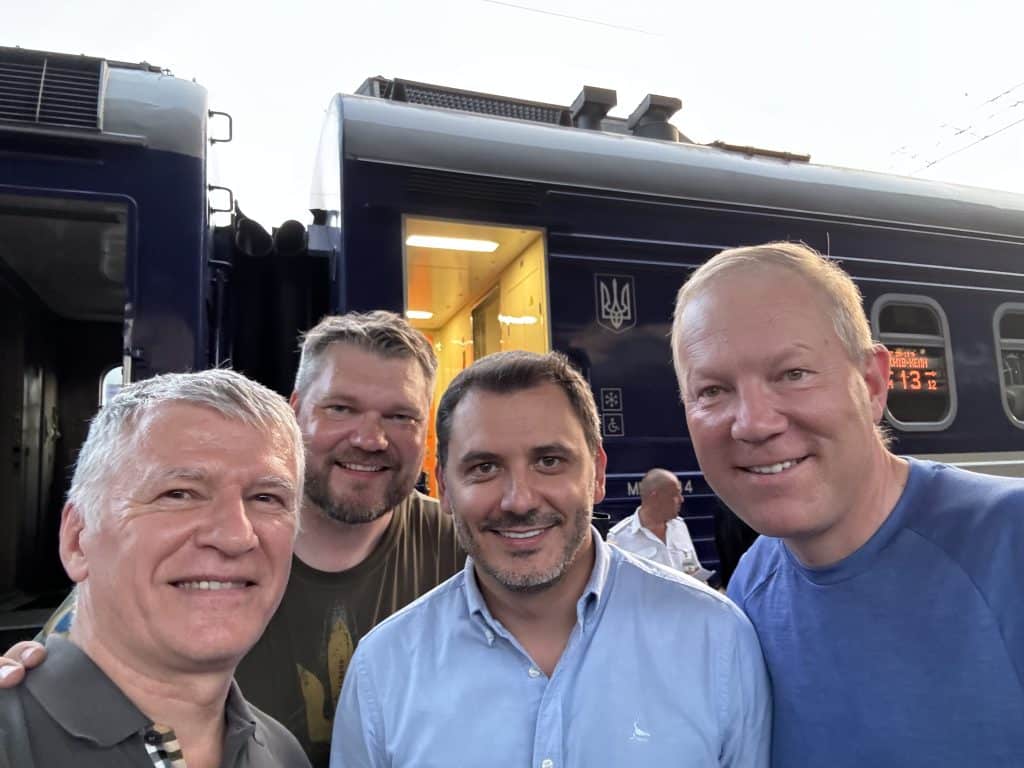
Conclusion (Conclusion)
It was clear to me during this visit that the Ukrainian offensive in the Kursk region has undeniably had a positive impact on the morale of both fighters and Ukrainian civilians. Indeed, the Russian steamroller has been in action in the Donbass for several months now, and over and above the number of combatants, it is above all the weight of the ammunition that is having an effect. Depending on the sector, the difference in artillery fire ranges from 1 to 3 to 1 to 10. When the Russians fire ten shells, the Ukrainians can only respond once. As a result, the Ukrainian strategy is to retreat as slowly as possible, while trying to inflict the heaviest possible losses on their adversary. In 15 days, Ukrainian forces have taken back as much territory from the Russians as they lost in a year in the Donbass. Not only is this good for morale, but during this offensive, the Ukrainians took many Russian soldiers prisoner, which can now rebalance trade prospects, and give all the more hope to the prisoners’ families. Let’s not forget that while the Ukrainians are fighting for their country, its territorial integrity and independence, they are also fighting for our shared values. They are up against adversaries who are more interested in financial logic. What’s more, the day Putin is cornered at the negotiating table, the Ukrainian occupation of part of the Kursk region will of course be an important bargaining chip.
For me, this war must lead us to completely rethink our programmatic stakes and tactical approaches. The “dronization” of the battlefield is a reality that is constantly evolving, and my observation of this past week is nothing like what I saw a year ago. While for Eurodrone we are in conjectures, participations and exchanges that should lead to a delivery from… 2030, the Ukrainians are going to produce 700,000 drones this year, much more in the following years!!!! Drones that go further and further (having already hit Moscow) and carry heavier and heavier loads, faster and faster, not to mention swarms of drones that bring us closer to the world of science fiction. To survive, they adapt and develop unsuspected abilities. In another symbolic move, Ukraine, which has virtually no navy, has taken control of a large part of the Black Sea with its naval drones, routing the formidable Black Sea Fleet based in Crimea. It’s a lesson that our country will also have to learn from, especially as we have the world’s largest maritime domain. I’ll be sure to pass on all this feedback to my colleagues on the Senate’s Foreign Affairs, Defense and Armed Forces Committee, so that together we can draw conclusions, just as my colleagues and friends Marko and Nikko and I will be doing within the NATO Parliamentary Assembly for future action.
It would have been a good idea to move away from the too little, too slow, too late that we saw with tanks and then with fighter jets for the deep strike system, and now support our Ukrainian allies more fully and more actively. We must, as President Zelinsky rightly demands, lift the restrictions on the use of certain weapons which severely penalize them. It’s worth remembering that Ukrainians have always respected the limits set by their allies and international conventions on the use of weapons, unlike their adversaries.
Even in these difficult times, Ukrainians have not lost their sense of humor. Seeing a poster in Kharkiv calling for mobilization to join the army, I was told that the translation of the slogan meant “come and picnic with us”. Let’s just hope the “picnic” lasts as short a time as possible and becomes more bucolic.
